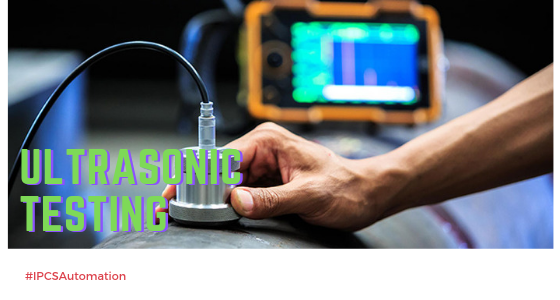
The basic principle of UT is Propagation and reflection of sound waves. If a sound wave is generated at on end of the material, it will travel through the workpiece and reflect back to the receiver. A free, as well as a defected end of a component, is able to reflect sound waves. If there is a presence of a discontinuity in the testing material, a part/entire wave will get reflected back and move to the receiver. The defect will be shown in the monitor by plotting the variation of echo on an intensity – time graph
The functional units of a UT inspection system are
- Receiver/pulser
- Transducer
- Display device
Receiver/pulser is an electronic device which can produce high voltage electric pulses. This electric pulse then moves to the transducer. The transducer then generates high-frequency ultrasonic energy and propagate it through the workpiece. If there is a presence of discontinuity the propagated waves will get reflected back to the transducer. The transducer converts the received energy into electrical signals and displays it on the screen.
Wave propagation
All materials are composed of atoms. Which may be forced into vibrational motion about their equilibrium position. Actually, sound waves can propagate in four modes based on the particle oscillation. They are longitudinal waves, shear waves, surface waves, and line waves. Among these longitudinal and shear waves are used for Ultrasonic Testing
Probe
The probe is otherwise called a transducer. It consists of a pair of electric disks integrated for transmitting or receiving sound echo. The Transducer consist of a piezoelectric element that converts electrical energy to mechanical energy, and vice versa.
Types of transducers
- Contact transducers
- Immersion transducers
Classification of UT
- Pulse-Echo and through Transmission
- Normal beam and angle beam
- Contact and immersion
Couplant
If you place the transducer on to the workpiece, no echo will see on the monitor because the probe has a too small contact area (acoustic impedance mismatch between air and solid) compared to the workpiece. Only with the use of couplant the sound waves can get in and out of the workpiece. The couplant facilitate the entry of maximum sound energy to the work specimen.
Deep knowledge in this area is important to carry out an inspection precisely. So we “IPCS AUTOMATION” will guide you and mold you in reaching the extreme of NDT. Come on and join us, we can make the world excellent in quality and assurance.
IPCS Automation is one of the most reliable NDT training centers in Trivandrum, with fascinating infrastructure. We IPCS Automation is predominant with sophisticated faculties. We are well equipped with all theoretical and practical experiments. To accrue a deep knowledge in NDT and to frame a better future in the NDT sector, reach as asap. To know more details visit: NDT Course in Trivandrum.
